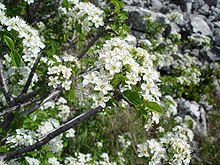- Prunus mahaleb
-
Prunus mahaleb 
Spring flowers of St. Lucie cherry Scientific classification Kingdom: Plantae (unranked): Angiosperms (unranked): Eudicots (unranked): Rosids Order: Rosales Family: Rosaceae Genus: Prunus Species: P. mahaleb Binomial name Prunus mahaleb
L.[1]Prunus mahaleb (syn. Cerasus mahaleb (L.) Mill.; St Lucie cherry, also occasionally Rock cherry[2] or Mahaleb cherry) is a species of cherry native to central and southern Europe, western and central Asia, and northwest Africa, from Morocco north to France, southern Belgium, and Germany, and east to northern Pakistan and Kyrgyzstan.[3][4][5]
It is a deciduous tree or large shrub, growing to 2–10 m (rarely up to 12 m) tall with a trunk up to 40 cm diameter. The bark is grey-brown, with conspicuous lenticels on young stems, and shallowly fissured on old trunks. The leaves are 1.5-5 cm long, 1-4 cm. wide, alternate, clustered at the end of alternately arranged twigs, ovate to cordate, pointed, have serrate edges, longitudinal venation and are glabrous and green. The petiole is 5-20 mm, and may or may not have two glands. The flowers are fragrant, pure white, small, 8-20 mm diameter, with an 8-15 mm pedicel; they are arranged 3-10 together on a 3-4 cm long raceme. The flower pollination is mainly by bees. The fruit is a small thin-fleshed cherry-like drupe 8–10 mm in diameter, green at first, turning red then dark purple to black when mature, with a very bitter flavour; flowering is in mid spring with the fruit ripening in mid to late summer.[4][6][7]
Contents
Ecology
Prunus mahaleb occurs in thickets and open woodland on dry slopes; in central Europe at altitudes up to 1,700 m, and in highlands at 1,200-2,000 m in southern Europe.[7]
It demonstrates selective fruit abortion, producing a high proportion of excess flowers that result in low fruit set levels. This reduces the number of "poor quality" fruit and increases the viability of its seeds.[8][9]
A scientific study[10] discovered an ecological dependence between the plant and four species of frugivorous birds in southeastern Spain; Blackbirds and Blackcaps proved to be the most important seed dispersers. When Prunus mahaleb is fruiting, these birds consume the fruit almost exclusively, and disperse the seeds to the locations favourable for the tree's growth. The way in which some birds consume the fruits and the habitats those birds use may act as a selective force in determining which genetic variations of the cherry flourish. [11]
Cultivation and uses
Main article: MahlabThe plant is cultivated for a spice, which is fragrant and has the taste of bitter almonds. It is used in small quantities to sharpen sweet foods, such as the Turkish sweet-bread çörek (chorak), the Greek sweet-bread tsoureki or the Armenian sweet-bread chorak. The chemical constituents are still uncertain, but the spice is prepared from the seeds, either by grinding and powdering the seed kernels, or in oil extracted from the seeds.[12]
The wood is hard, and is used in cabinet-making and for pipes.[13]
The bark, wood, and seeds contain coumarin.[13][14] They have anti-inflammatory, sedative and vasodilation effects.
Away from its native range, the species is grown as an ornamental tree for its strongly fragrant flowers, throughout temperate regions of the world; it has become naturalised in some areas, including Europe north of its native range (north to Great Britain and Sweden), and locally in Australia and the United States.[7][15][16]
A number of cultivars have been selected, including 'Albomarginata', with variegated foliage, 'Bommii', a dwarf with strongly pendulous branches, 'Globosa', a compact dwarf clone, 'Pendula', with drooping branching, and 'Xanthocarpa' with yellow fruit.[17]
Etymology
The plant was described scientifically in the first edition of Linnaeus' Species Plantarum (1753).[18] The specific name was generally in use for the plant in a number of different languages, with slight differences in spelling. When it first began to be used is unknown, as it was to the contemporaries and post-contemporaries of Linnaeus. It does not appear in ancient literature. The Oxford English dictionary does offer an etymology: mahaleb comes from Arabic محلب al-mahlab, probably meaning "a kind of perfume or sweet smell".[19]
References
- ^ "Prunus mahaleb information from NPGS/GRIN". www.ars-grin.gov. http://www.ars-grin.gov/cgi-bin/npgs/html/taxon.pl?30034. Retrieved 2008-03-14.
- ^ Note: Rock cherry is also used for Prunus prostrata.
- ^ Euro+Med Plantbase Project: Prunus mahaleb
- ^ a b Rushforth, K. (1999). Trees of Britain and Europe. Collins ISBN 0-00-220013-9.
- ^ Germplasm Resources Information Network: Prunus mahaleb
- ^ Flora of NW Europe: Prunus mahaleb
- ^ a b c Blamey, M. & Grey-Wilson, C. (1989). Flora of Britain and Northern Europe. ISBN 0-340-40170-2.
- ^ Guitian, J. (1993). Why Prunus mahaleb (Rosaceae) Produces More Flowers Than Fruits. Amer. J. Bot. 80 (11): 1305-1309.
- ^ Guitian, J. (1994). Selective Fruit Abortion in Prunus mahaleb (Rosaceae). Amer. J. Bot. 81 (12): 1555-1558.
- ^ Herrera, C. M., & Jordano, P. (1981). Prunus mahaleb and Birds: The High-Efficiency Seed Dispersal System of a Temperate Fruiting Tree. Ecol. Monogr. 51 (2): 203-218. Abstract.
- ^ Guitián, J. et al. (1992). Spatial Variation in the Interactions between Prunus mahaleb and Frugivorous Birds. Oikos 63 (1): 125-130.
- ^ Gernot Katzer's Spice Pages: Mahaleb Cherry (Prunus mahaleb L.)
- ^ a b Vedel, H., & Lange, J. (1960). Trees and Bushes in Wood and Hedgerow. Metheun & Co. Ltd., London.
- ^ El-Dakhakhny, M. (2006). Some coumarin constituents of Prunus mahaleb L. fruit kernels. J. Pharm. Sci. 59 (4): 551-553. Abstract.
- ^ New South Wales Flora: Prunus mahaleb
- ^ USDA Plants Profile: Prunus mahaleb
- ^ Bean, W. J. (1976). Trees and Shrubs Hardy in the British Isles. John Murray ISBN 0-7195-2427.
- ^ Linnaean Herbarium: Prunus mahaleb L.
- ^ Oxford English Dictionary. Oxford University Press.
External links
Categories:- Prunus
- Flora of Lebanon
Wikimedia Foundation. 2010.

